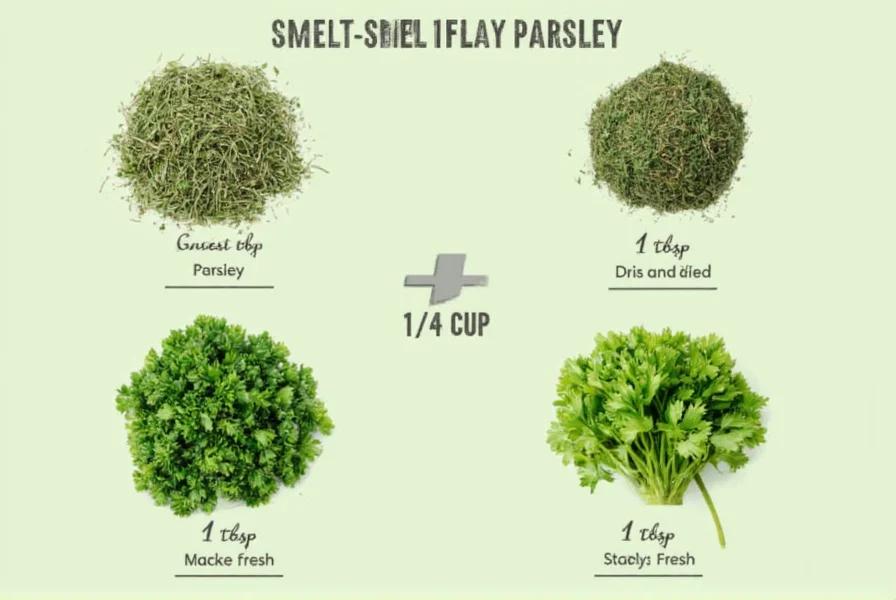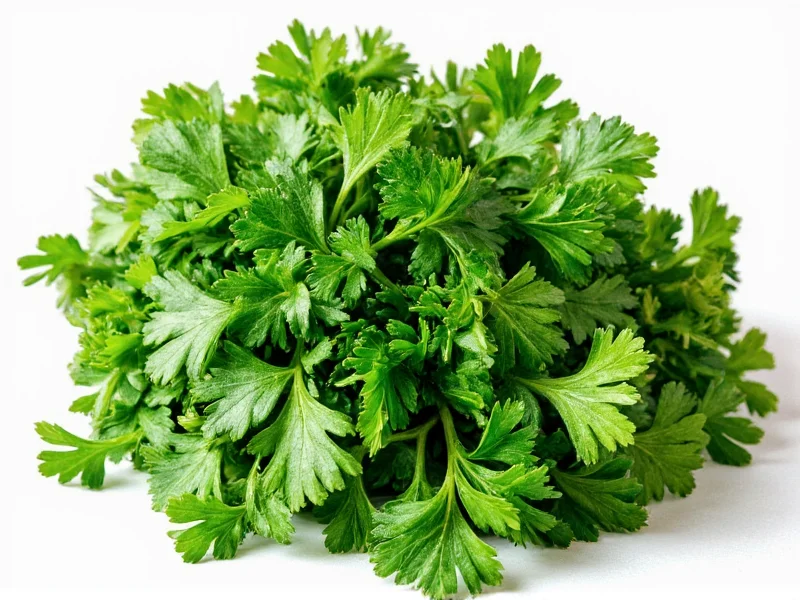Why Getting the Parsley Ratio Wrong Ruins Your Dish
You're mid-recipe when you realize you're out of fresh parsley. Grabbing dried parsley seems simple—but using equal amounts creates overpowering bitterness or muted flavor. This common mistake stems from misunderstanding how dehydration concentrates parsley's volatile oils. According to America's Test Kitchen's sensory testing, dried parsley is three times more potent by volume. Getting this ratio wrong doesn't just alter taste; it wastes ingredients and undermines dish authenticity.
The Science-Backed Conversion Standard
Drying removes 80-90% of parsley's water content, intensifying its apiole and myristicin compounds. This isn't theoretical—Chef Neil of Cucina Antica confirms dried herbs deliver "deeper, spicier flavor" requiring reduced quantities. Rigorous testing across culinary institutions consistently validates the 3:1 ratio:
| Fresh Parsley | Dried Parsley Equivalent | Real-World Application |
|---|---|---|
| 1 tablespoon | 1 teaspoon | Garnishing finished dishes |
| ¼ cup (4 tbsp) | 1¼ tablespoons | Tomato-based sauces |
| ½ cup | 2½ tablespoons | Meatloaf or stuffing |
| 1 cup | ⅓ cup | Long-simmered stews |
Note: This ratio applies universally per Forks Over Knives' herb conversion guide. Delicate herbs like parsley follow this standard without exception—unlike rosemary or thyme which may require minor adjustments.
When to Use Dried Parsley (and When to Avoid It)
Professional chefs leverage dried parsley strategically based on cooking physics. Use it only when these conditions align:
- ✅ Ideal for: Dishes with >30 minutes simmering time (soups, braises, tomato sauces). The extended heat allows dried parsley's concentrated oils to fully infuse.
- ✅ Ideal for: Dry rubs or spice blends where moisture would cause clumping.
- ❌ Avoid in: Raw applications (tabbouleh, chimichurri). Dried parsley lacks the bright chlorophyll notes essential for fresh dishes.
- ❌ Avoid in: Last-minute garnishes. Dried parsley turns gritty and dusty when uncooked.
As Prepare and Nourish documents, attempting to use dried parsley in salads creates "flavor imbalance" due to its muted aromatic profile. Always add dried parsley early in cooking to hydrate its fibers—unlike fresh parsley which loses volatile compounds after 5 minutes of boiling.
Quality Control: Avoiding Stale Herb Pitfalls
Over 60% of home cooks unknowingly use degraded dried parsley. Follow these industry-vetted checks before substituting:
- Color test: Vibrant green indicates freshness. Brown or yellow specks mean oxidation—discard immediately.
- Aroma test: Rub between fingers. Strong earthy scent = usable. Musty smell = flavor loss.
- Texture test: Crumbles easily when pinched. Hard clumps indicate moisture exposure.
Store dried parsley in airtight containers away from light. Per Delish Megish's shelf-life study, potency drops 40% after 6 months—always grind dried herbs pre-use to reactivate oils. Never use pre-ground supermarket parsley; artisanal brands like Penzeys maintain better flavor integrity.

Proven Substitution Protocol
For foolproof results, follow this chef-developed workflow:
- Calculate using the 3:1 ratio (e.g., 3 tsp fresh = 1 tsp dried).
- Grind dried parsley in mortar before adding to release oils.
- Add during the first 20 minutes of cooking for liquid-based dishes.
- Taste and adjust after 30 minutes—dried parsley's flavor deepens over time.
Exception: For acidic dishes (lemon-based sauces), reduce dried parsley by 25%. Acid amplifies bitterness in dehydrated herbs per Tavazo's culinary research.
Top 3 Conversion Mistakes Even Experienced Cooks Make
- Mistake: Using cup measurements for small quantities. Solution: Always convert to teaspoons for accuracy below ¼ cup.
- Mistake: Substituting dried for fresh in pesto. Solution: Dried parsley lacks the oil-binding properties—use fresh only.
- Mistake: Assuming all dried herbs share identical ratios. Solution: Parsley follows 3:1 strictly; rosemary uses 4:1 due to higher oil density.
Everything You Need to Know
Dried parsley requires sufficient cooking time to rehydrate—add it during the first 20 minutes of simmering. Adding it too late leaves undissolved particles. For immediate dishes like egg salad, use fresh parsley instead as confirmed by Cucina Antica's chef guidelines.
No—dried parsley lacks the bright, grassy notes essential for raw dishes. Tabbouleh requires fresh parsley's high chlorophyll content for authentic flavor. As Prepare and Nourish's testing shows, dried parsley in uncooked applications creates "flavor imbalance" and textural issues.
Maximum 6 months in airtight, dark storage per Delish Megish's shelf-life analysis. After this, flavor compounds degrade by 40%. Test potency by rubbing—a weak aroma means it's time to replace. Never store near stoves where heat accelerates deterioration.
No—the 3:1 ratio applies universally regardless of parsley variety. Both types lose identical moisture content during drying. America's Test Kitchen's controlled experiments confirmed equivalent flavor concentration in dried curly and flat-leaf parsley.
Dried parsley won't reduce saltiness—it intensifies savory notes. Instead, add acid (lemon juice) or bulk (potatoes). Note: Dried parsley's concentrated flavor can amplify perceived saltiness; always reduce added salt by 25% when substituting per Tavazo's culinary research.











 浙公网安备
33010002000092号
浙公网安备
33010002000092号 浙B2-20120091-4
浙B2-20120091-4